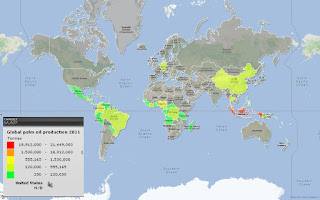 |
| Palm Oil |
Palm Oil Production
As of 2012, the annual revenue received by Indonesia and Malaysia together, the Top two producers of palm oil, is US$40 billion. Between 1962 and 1982 global exports of palm oil increased from around half a million to 2.4 million tonnes annually and in 2008 world production of palm oil and palm kernel oil amounted to 48 million tonnes. According to FAO forecasts by 2020 the global demand for palm oil will double, and triple by 2050.
A map of world Palm Oil Production output
 |
| Map of Palm Oil Production |
Indonesia
Indonesia is the largest producer of palm oil, surpassing Malaysia in 2006, producing more than 20.9 million tonnes. Indonesia expects to double production by the end of 2030. At the end of 2010, 60 percent of the output was exported in the form of Crude Palm Oil. FAO data show production increased by over 400% between 1994 and 2004, to over 8.66 million metric tonnes.
Malaysia
In 2012, Malaysia, the world's second largest producer of palm oil, produced 18.79 million tonnes of crude palm oil on roughly 5,000,000 hectares (19,000 sq mi) of land. Though Indonesia produces more palm oil, Malaysia is the world's largest exporter of palm oil having exported 18 million tonnes of palm oil products in 2011. China, Pakistan, the European Union, India and the United States are the primary importers of Malaysian palm oil products.
Nigeria
As of 2011, Nigeria was the third-largest producer, with approximately 2.3 million hectares (5.7×106 acres) under cultivation. Until 1934, Nigeria had been the world's largest producer. Both small- and large-scale producers participated in the industry.
Thailand
In 2013, Thailand produced 2.0 million tonnes of crude palm oil on roughly 626 thousand hectares.
Colombia
In the 1960s, about 18,000 hectares (69 sq mi) were planted with palms. Colombia has now become the largest palm oil producer in the Americas, and 35% of its product is exported as biofuel. In 2006, the Colombian plantation owners' association, Fedepalma, reported that oil palm cultivation was expanding to 1,000,000 hectares (3,900 sq mi). This expansion is being funded, in part, by the United States Agency for International Development to resettle disarmed paramilitary members on arable land, and by the Colombian government, which proposes to expand land use for exportable cash crops to 7,000,000 hectares (27,000 sq mi) by 2020, including oil palms. Fedepalma states that its members are following sustainable guidelines.
Some Afro-Colombians claim that some of these new plantations have been expropriated from them after they had been driven away through poverty and civil war, while armed guards intimidate the remaining people to further depopulate the land, with coca production and trafficking following in their wake.
Benin
Palm is native to the wetlands of western Africa, and south Benin already hosts many palm plantations. Its 'Agricultural Revival Programme' has identified many thousands of hectares of land as suitable for new oil palm export plantations. In spite of the economic benefits, Non-governmental organisations (NGOs), such as Nature Tropicale, claim biofuels will compete with domestic food production in some existing prime agricultural sites. Other areas comprise peat land, whose drainage would have a deleterious environmental impact. They are also concerned genetically modified plants will be introduced into the region, jeopardizing the current premium paid for their non-GM crops.
Cameroon
Cameroon has a production project underway initiated by Herakles Farms in the US. However, the project has been halted under the pressure of Greenpeace, WWF and other civil society organizations in Cameroon. Before the project was halted, Herakles left the Roundtable on Sustainable Palm Oil (RSPO) early on in negotiations. The project has been controversial due to opposition from villagers and the location of the project in a biodiversity hotspot.
Kenya
Kenya's domestic production of edible oils covers about a third of its annual demand, estimated at around 380,000 metric tonnes. The rest is imported at a cost of around US$140 million a year, making edible oil the country's second most important import after petroleum.
Since 1993 a new hybrid variety of cold-tolerant, high-yielding oil palm has been promoted by the Food and Agriculture Organization of the United Nations in western Kenya. As well as alleviating the country's deficit of edible oils while providing an important cash crop, it is claimed to have environmental benefits in the region, because it does not compete against food crops or native vegetation and it provides stabilisation for the soil.
Ghana
Ghana has a lot of palm nut species, which may become an important contributor to the agriculture of the region. Although Ghana has multiple palm species, ranging from local palm nuts to other species locally called agric, it was only marketed locally and to neighboring countries. Production is now expanding as major investment funds are purchasing plantations, because Ghana is considered a major growth area for palm oil.
Other countries
A satellite image showing deforestation in Malaysian Borneo to allow the plantation of oil palm.
Markets
According to the Hamburg-based Oil World trade journal, in 2008 global production of oils and fats stood at 160 million tonnes. Palm oil and palm kernel oil were jointly the largest contributor, accounting for 48 million tonnes, or 30% of the total output. Soybean oil came in second with 37 million tonnes (23%). About 38% of the oils and fats produced in the world were shipped across oceans. Of the 60.3 million tonnes of oils and fats exported around the world, palm oil and palm kernel oil made up close to 60%; Malaysia, with 45% of the market share, dominated the palm oil trade.
 |
| Global Palm Oil Consumtion |
Food label regulations
Previously, palm oil could be listed as "vegetable fat" or "vegetable oil" on food labels in the European Union (EU). From December 2014, food packaging in the EU is no longer allowed to use the generic terms "vegetable fat" or "vegetable oil" in the ingredients list. Food producers are required to list the specific type of vegetable fat used, including palm oil. Vegetable oils and fats can be grouped together in the ingredients list under the term "vegetable oils" or "vegetable fats" but this must be followed by the type of vegetable origin (e.g. palm, sunflower or rapeseed) and the phrase "in varying proportions".
Nutrition and health
Palm oil is also an important source of calories and a food staple in poor communities. However its overall health impacts, particularly in relation to cardiovascular disease, are controversial and subject to ongoing research.
Much of the palm oil that is consumed as food is to some degree oxidized rather than in the fresh state, and this oxidation appears to be responsible for the health risk associated with consuming palm oil.
Cardiovascular disease
Several studies have linked palm oil and cardiovascular disease including a 2005 study conducted in Costa Rica which indicated that replacing palm oil in cooking with polyunsaturated non-hydrogenated oils could reduce the risk of heart attacks, and a 2011 analysis of 23 countries which showed that for each kilogram of palm oil added to the diet annually there was an increase in ischemic heart disease deaths (68 deaths per 100,000 increase) though the increase was much smaller in high-income countries.
However, results from several studies indicate that palm oil provides health benefits, including increasing good cholesterol and reducing bad cholesterol, and that consumption of palm oil does not increase the risk of cerebrovascular disease.
Palmitic acid
According to studies reported on by the Center for Science in the Public Interest (CSPI), excessive intake of palmitic acid, which makes up 44 percent of palm oil, increases blood cholesterol levels and may contribute to heart disease. The CSPI also reported that the World Health Organization and the US National Heart, Lung and Blood Institute have encouraged consumers to limit the consumption of palmitic acid and foods high in saturated fat. According to the World Health Organization, evidence is convincing that consumption of palmitic acid increases risk of developing cardiovascular diseases, placing it in the same evidence category as trans fatty acids.
However, a 1993 study published by the United Nations University Press found that consumption of palmitic acid appeared to have no impact on cholesterol levels when daily cholesterol intake is below 400 mg per day.
Comparison to trans fats
In response to negative reports on palm oil many food manufacturers transitioned to using hydrogenated vegetable oils in their products, which have also come under scrutiny for the impact these oils have on health. A 2006 study supported by the National Institutes of Health and the USDA Agricultural Research Service concluded that palm oil is not a safe substitute for partially hydrogenated fats (trans fats) in the food industry, because palm oil results in adverse changes in the blood concentrations of LDL cholesterol and apolipoprotein B just as trans fat does.
However, according to two reports published in 2010 by the Journal of the American College of Nutrition palm oil is again an accepted replacement for hydrogenated vegetable oils and a natural replacement for partially hydrogenated vegetable oils, which are a significant source of trans fats.
 |
| Palm olein vs olive oil |
Comparison with animal saturated fat
Not all saturated fats have equally cholesterolemic effects. Studies have indicated that consumption of palm olein (which is more unsaturated) reduces blood cholesterol when compared to sources of saturated fats like coconut oil, dairy and animal fats.
In 1996, Dr Decker of University of Massachusetts Medical School stressed that saturated fats in the sn–1 and -3 position of triacylglycerols exhibit different metabolic patterns because of their low absorptivity. Dietary fats containing saturated fats primarily in sn–1 and -3 positions (e.g., cocoa butter, coconut oil, and palm oil) have very different biological consequences than those fats in which the saturated fats are primarily in the sn–2 position (e.g., milk fat and lard). Differences in stereospecific fatty acid location should be an important consideration in the design and interpretation of lipid nutrition studies and in the production of specialty food products.
Acrolein
A 2009 study tested the emission rates of acrolein, a toxic and malodorous breakdown product from glycerol, from the deep-frying of potatoes in red palm, olive, and polyunsaturated sunflower oils. The study found higher acrolein emission rates from the polyunsaturated sunflower oil (the scientists characterized red palm oil as "mono-unsaturated") and lower rates from both palm and olive oils. The World Health Organization established a tolerable oral acrolein intake of 7.5 mg/day per kilogram of body weight. Although acrolein occurs in French fries, the levels are only a few micrograms per kilogram. A 2011 study concluded a health risk from acrolein in food is unlikely.
You may also like this : Social and Environmental Impact of Palm Oil
Roundtable on Sustainable Palm Oil / RSPO
No comments:
Post a Comment